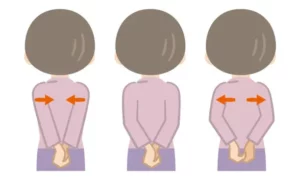Ankylosing spondylitis (AS) is a chronic inflammatory condition that primarily affects the spine. However, many individuals with AS also experience pain and stiffness in their shoulders. This can be particularly challenging as it limits mobility and affects daily life. In this blog, we’ll explore ankylosing spondylitis shoulder pain, its causes, and effective strategies for managing and finding relief.
Contents
Understanding Ankylosing Spondylitis And Its Impact On The Shoulders
Ankylosing spondylitis (AS) is a chronic autoimmune condition that primarily affects the spine and sacroiliac joints. However, the impact of AS can extend beyond the axial skeleton to involve other joints, including the shoulders. Understanding how AS affects the shoulders is crucial for individuals living with this condition.
- Inflammation and Pain: AS is characterized by inflammation, which can occur at the sites where tendons and ligaments attach to bone, known as entheses. In the shoulders, inflammation can affect the tendons, joint capsules, and synovial lining. This inflammation leads to pain, swelling, and stiffness in the shoulder joints, making movements difficult.
- Reduced Range of Motion: Over time, untreated or inadequately managed AS can lead to the fusion of spinal vertebrae and joints. This fusion can also extend to the shoulder joints. As the joints fuse, the range of motion in the shoulders becomes limited. Individuals with AS often find it challenging to lift their arms overhead, reach behind their backs, or perform daily tasks that require shoulder mobility.
- Postural Changes: AS can cause significant postural changes, including kyphosis or stooping forward. These changes affect the alignment of the spine and shoulders. The altered posture can put extra stress on the shoulder joints, exacerbating pain and reducing function.
- Secondary Conditions: AS can contribute to secondary conditions like rotator cuff tendinitis or bursitis. These conditions can cause additional pain and discomfort in the shoulders, compounding the challenges faced by individuals with AS.
- Impact on Daily Life: Shoulder involvement in AS can impact daily life in various ways. Tasks such as dressing, grooming, reaching for objects, or even driving can become more difficult. The pain and stiffness can also interfere with sleep and overall quality of life.
- Response to Treatment: Early diagnosis and effective treatment of AS can help manage shoulder involvement. Medications such as nonsteroidal anti-inflammatory drugs (NSAIDs) and biologics can reduce inflammation and alleviate pain. Physical therapy can improve shoulder mobility, and lifestyle modifications can help reduce strain.
Causes Of Shoulder Pain In Ankylosing Spondylitis
Shoulder pain in ankylosing spondylitis (AS) primarily arises due to the inflammation and structural changes that occur in the shoulder joints. Here are some key causes of shoulder pain in individuals with AS:
- Enthesitis: AS is characterized by enthesitis, which is inflammation at the sites where tendons and ligaments attach to bone. In the shoulders, enthesitis can affect the tendons and ligaments around the joint, leading to pain and swelling.
- Synovitis: Inflammation of the synovial lining of the shoulder joint is common in AS. This synovitis can result in joint pain, stiffness, and reduced range of motion.
- Structural Changes: Over time, AS can lead to structural changes in the shoulder joints. These changes may include joint erosion, bone spurs, and joint fusion (ankylosis). These alterations can contribute to pain and limit shoulder mobility.
- Secondary Conditions: AS can predispose individuals to secondary conditions such as rotator cuff tendinitis or bursitis. These conditions can further exacerbate shoulder pain and dysfunction.
- Postural Changes: AS often causes changes in posture, including kyphosis (forward stooping) and rounded shoulders. These altered postures can put additional stress on the shoulder joints, leading to pain and discomfort.
- Reduced Chest Expansion: AS can restrict chest expansion due to spinal and rib involvement. Limited chest expansion can indirectly affect shoulder function, making it challenging to lift the arms and perform overhead movements.
- Muscle Weakness: Chronic pain and inflammation can lead to muscle weakness and atrophy around the shoulder joint. Weakened muscles may struggle to support and stabilize the joint, contributing to pain and decreased function.
- Impaired Blood Flow: In some cases, AS-related inflammation can affect blood vessels, potentially reducing blood flow to the shoulders and surrounding tissues. This can lead to ischemic pain and muscle discomfort.
Exercises For Ankylosing Spondylitis For Shoulder Pain Relief
Exercise is an essential component of managing ankylosing spondylitis (AS) and can help alleviate shoulder pain and maintain joint flexibility. However, it’s crucial for AS patients to perform exercises that are safe and appropriate for their condition. Here are some shoulder exercises suitable for individuals with AS:
Cross-Body Arm Stretch
- Extend your affected arm across your body at shoulder height.
- Use your opposite hand to gently pull your arm closer to your chest.
- Hold the stretch for 20-30 seconds on each side.
Pendulum Swing
- Stand or sit with your unaffected hand resting on a surface.
- Gently swing your affected arm forward and backward, then side to side in a circular motion.
- Perform this exercise for 1-2 minutes to promote gentle stretching and mobility in the shoulder.
Wall Crawls
- Stand facing a wall with your fingertips lightly touching the wall.
- Slowly crawl your fingers up the wall as high as you comfortably can then crawl them back down.
- Perform 10-15 repetitions to improve shoulder mobility.
Corner Stretch
- Stand facing a corner of a room.
- Place your hands on either side of the corner, at shoulder height.
- Lean forward gently, allowing your chest to approach the corner while keeping your feet in place.
- Hold the stretch for 20-30 seconds, and repeat it 2-3 times. This stretches the chest and shoulders.
Resistance Band Rows
- Secure a resistance band at chest height.
- Grasp the ends of the band with your hands and step back to create tension.
- Pull your hands towards your chest, squeezing your shoulder blades together.
- Perform 10-15 repetitions to strengthen the upper back and shoulders.
Wall Angels
- Stand with your back against a wall and your arms against the wall at shoulder height.
- Slowly slide your arms upward, maintaining contact with the wall, and then return them to shoulder height.
- Perform 10-15 repetitions to improve shoulder mobility and stability.
Scapular Retraction
- Sit or stand with your arms at your sides.
- Focus on squeezing your shoulder blades together without shrugging your shoulders.
- Hold the contraction for 5-10 seconds and release.
- Repeat this exercise 10-15 times to promote better posture and shoulder stability.
Wall Presses
- Stand with your back against a wall and your arms bent at 90-degree angles, palms facing forward.
- Press your arms against the wall, then relax.
- Perform 10-15 repetitions to activate the muscles that support good posture.
Managing Ankylosing Spondylitis Shoulder Pain
Managing shoulder pain associated with ankylosing spondylitis (AS) involves a multifaceted approach that includes medical treatment, physical therapy, and lifestyle adjustments. Here are some strategies for effectively managing AS-related shoulder pain:
- Medications: Nonsteroidal anti-inflammatory drugs (NSAIDs) can help reduce pain and inflammation in the shoulder joints. Disease-modifying antirheumatic drugs (DMARDs) may be prescribed to slow the progression of AS and manage symptoms. Biologic medications, such as tumor necrosis factor (TNF) inhibitors, are often used for more severe cases of AS.
- Physical Therapy: Work with a physical therapist who specializes in AS to develop a tailored exercise program. They can teach you exercises that improve shoulder mobility, strength, and flexibility. Postural exercises can also help you maintain better posture, reducing the strain on your shoulders.
- Hot and Cold Therapy: Applying heat, such as a warm compress or heating pad, can help relax tense muscles and ease shoulder discomfort. Cold packs, on the other hand, can be used to reduce inflammation and numb pain. Alternate between hot and cold treatments as needed.
- Pain Management Techniques: Relaxation techniques, such as deep breathing exercises and meditation, can help manage pain and reduce stress. Over-the-counter pain-relieving creams or gels may provide localized relief when applied to the affected shoulder area.
- Ergonomic Adjustments: Modify your workspace and daily activities to reduce strain on your shoulders. Ensure that your computer monitor is at eye level, use an ergonomic chair, and maintain good posture. Use assistive devices for tasks that require heavy lifting.
- Rest and Sleep: Adequate rest is crucial for managing pain and fatigue associated with AS. Ensure you get enough sleep and consider using supportive pillows to maintain proper spinal alignment while sleeping.
- Supportive Devices: Orthopedic devices, such as shoulder braces or slings, can help stabilize the shoulder joint and provide support during activities.
Preventing Ankylosing Spondylitis Flare-Ups
Preventing flare-ups and effectively managing shoulder pain in ankylosing spondylitis (AS) is crucial for maintaining a good quality of life. Here are some strategies that can help you prevent and manage flare-ups:
- Posture Awareness: Pay close attention to your posture, both while sitting and standing. Avoid slouching and use ergonomic chairs or cushions to support your spine. Consider regular posture checks to ensure you’re maintaining proper alignment.
- Pain Management Techniques: Practice relaxation techniques like deep breathing, meditation, or guided imagery to manage pain and reduce stress. Mindfulness-based stress reduction programs can also be beneficial.
- Rest and Sleep: Prioritize restful sleep to aid in pain management and overall well-being. Ensure you have a comfortable mattress and use supportive pillows. If pain disrupts your sleep, consider discussing sleep aids or strategies with your healthcare provider.
- Regular Exercise: Engage in regular low-impact exercises like swimming, walking, or yoga (Find Online Yoga Experts) to maintain joint mobility and prevent stiffness. Avoid high-impact activities that could exacerbate shoulder pain.
- Diet and Nutrition: Maintain a balanced diet to support overall health and weight management. A registered dietitian can help you create a suitable meal plan. Some people with AS find dietary modifications, such as reducing inflammatory foods, to be helpful.
- Psychological Support: Chronic pain conditions like AS can take a toll on mental health. Seek support from a therapist or counselor to address emotional aspects. Joining a support group with others who have AS can also provide valuable insights and emotional support.
Conclusion
In conclusion, managing shoulder pain in ankylosing spondylitis (AS) requires a proactive approach. Understanding the causes, symptoms, and treatments is key. By working with your healthcare provider, following treatment plans, and adopting lifestyle changes, you can reduce AS’s impact on your shoulders. Remember, you don’t have to face AS alone; a support system of healthcare professionals and loved ones can make a significant difference in your quality of life. With determination and the right tools, you can maintain an active and fulfilling life despite AS-related shoulder pain.
If you’re experiencing Shoulder pain, physical therapy for shoulder pain at PhysioMantra can help: Book an online physical therapy session.













